Using Jira and ServiceNow approval steps in CD pipelines
This topic describes how to add approval stages to your pipeline and use Jira and ServiceNow steps in the stages as criteria for approvals and rejections.
For more details, see Ticketing Systems.
Adding Jira approval stages and steps
You can use Jira issues to approve or reject a Pipeline or stage at any point in its execution.
During deployment, a Jira issue's fields are evaluated according to criteria you define and its approval/rejection determines if the Pipeline or stage may proceed.
The Jira Approval step can be added in Jira Approval stages or in CD stages. The Jira Approval step prevents the stage execution from proceeding without an approval.
For example, in a Kubernetes Blue Green Deployment, you might want to add an approval step between the Stage Deployment step, where the new app version is deployed to the staging environment, and the Swap Primary with Stage step, where production traffic is routed to the pods for the new version.
Looking to create or update Jira issues? See Create Jira Issues in CD Stages, Update Jira Issues in CD Stages.
Before you begin
Visual Summary
The following video shows you how to use the Jira Create, Jira Update, and Jira Approval steps:
Limitations
- Harness supports only Jira fields of type
Option,Array,Any,Number,Date, andString. Harness does not integrate with Jira fields that manage users, issue links, or attachments. This means that Jira fields like Assignee and Sprint are not accessible in Harness' Jira integration.
Review: Jira Approval Stages vs Steps
You can use Jira Approvals in two ways:
- Jira Approval step: you can add a Jira Approval step to any CD or Approval stage.
- Jira Approval stage: the Jira Approval stage includes Jira Create, Jira Approval, and Jira Update steps:
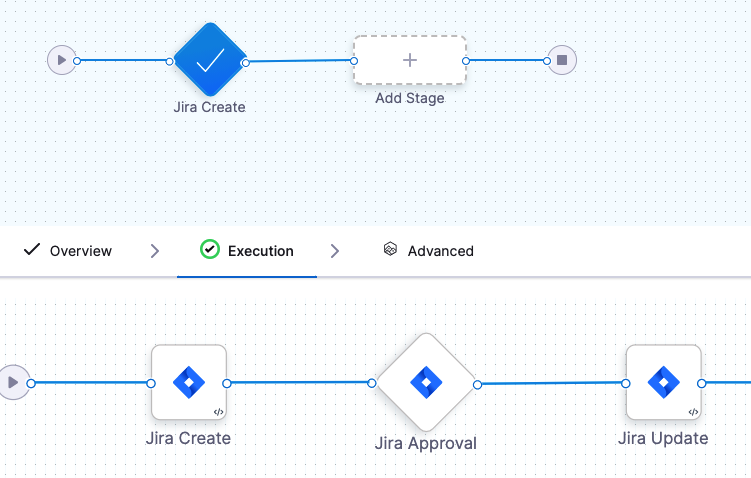
You do not need to use the Jira Create and Jira Update steps with the Jira Approval step, but they are included in the Jira Approval stage because many users want to create a Jira issue, approve/reject based on its settings, and then update the Jira issue all in one stage.
You can also achieve this simply by using the Jira Create, Jira Approval, and Jira Update steps within a non-Approval stage.
The Jira Create and Jira Update steps are described in other topics. This topic describes the Jira Approval step only.
See:
Step 1: Add a Jira Approval Step
In a CD or Approval stage, click Add Step, and then click Jira Approval.
When you add a Jira Approval stage, Harness automatically adds Jira Create, Jira Approval, and Jira Update steps. We'll only cover the Jira Approval step here.
In Name, enter a name that describes the step.
In Timeout, enter how long you want Harness to try to complete the step before failing (and initiating the stage or step Failure Strategy).
You can use **w** for week, **d** for day, **h** for hour, **m** for minutes, **s** for seconds and **ms** for milliseconds. For example, 1d for one day.
Jira communication can take a few minutes. Do not use a brief timeout.
The maximum is 3w 3d 20h 30m. In Jira Connector, create or select the Jira Connector to use.
In Project, select the Jira project that contains the issue you want to evaluate.
In Issue Key, enter the Jira issue key of the issue you want to evaluate.
In Retry Interval, set how long the step should wait to fetch details again for calculating Approval or Rejection criteria.
Passing Jira issue keys using expressions
In Issue Key, you can use an expression to reference the issue key from another Jira Create or Jira Update step.
Example pipeline
Here's an example pipeline showing a Jira Create step (with the Id Jira_Create) and two subsequent Jira Update steps, JiraUpdate_1 and JiraUpdate_2.
JiraUpdate_1 references the issue key from the Jira Create step using the expression <+pipeline.stages.Jira_Stage.spec.execution.steps.Jira_Create.issue.key>.
JiraUpdate_2 references the issue key from JiraUpdate_1 using the expression <+execution.steps.JiraUpdate_1.spec.issueKey>, but it could also use the expression <+pipeline.stages.Jira_Stage.spec.execution.steps.Jira_Create.issue.key>.
pipeline:
name: Jira
identifier: Jira
projectIdentifier: CD_Docs
orgIdentifier: default
tags: {}
stages:
- stage:
name: Jira Stage
identifier: Jira_Stage
description: ""
type: Approval
spec:
execution:
steps:
- step:
name: Jira Create
identifier: Jira_Create
type: JiraCreate
timeout: 5m
spec:
connectorRef: Jira
projectKey: TJI
issueType: Bug
fields:
- name: Summary
value: test for doc
- step:
type: JiraUpdate
name: JiraUpdate_1
identifier: JiraUpdate_1
spec:
connectorRef: Jira
issueKey: <+pipeline.stages.Jira_Stage.spec.execution.steps.Jira_Create.issue.key>
transitionTo:
transitionName: ""
status: In Progress
fields: []
timeout: 10m
- step:
type: JiraUpdate
name: JiraUpdate_2
identifier: JiraUpdate_2
spec:
connectorRef: Jira
issueKey: <+execution.steps.JiraUpdate_1.spec.issueKey>
transitionTo:
transitionName: ""
status: Will Not Fix
fields: []
timeout: 10m
tags: {}
Here's a video that demonstrates how to pass an issue key:
The expression follows the format <+pipeline.stages.STAGE_ID.spec.execution.steps.STEP_ID.issue.key>.
The Jira Create or Jira Update step you want to reference must be before the Jira Update step that references it in the pipeline and stage.
There are two ways to get the information for the expression:
-
Use the standard expression: In the Jira Update step Issue Key, select Expression, and then paste the expression
<+pipeline.stages.STAGE_ID.spec.execution.steps.STEP_ID.issue.key>with the correctSTAGE_IDandSTEP_IDvalues for the Jira Create step that creates the issue key. tip
tipWhen you have the Jira Create step open in Pipeline Studio, you can copy the
STAGE_IDandSTEP_IDvalues from the browser URL:stageId=STAGE_ID§ionId=EXECUTION&stepId=steps.0.step.STEP_ID.For example,
stageId=Jira_Stage§ionId=EXECUTION&stepId=steps.0.step.Jira_Create. -
Copy the expression from an executed step: Select a successful execution, and click the Jira Create step in the execution.
- Click the Output tab, locate the Key setting, and click the copy button.
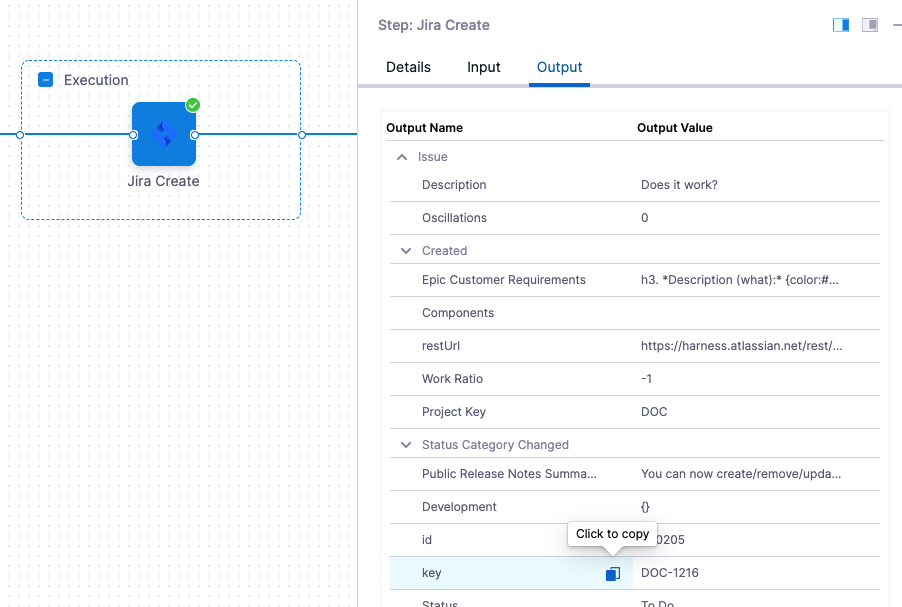
Now you have the expression that references the issue key from this step.
Go back to your Jira Update step. You can just select Edit Pipeline.
In Issue Key, select Expression.
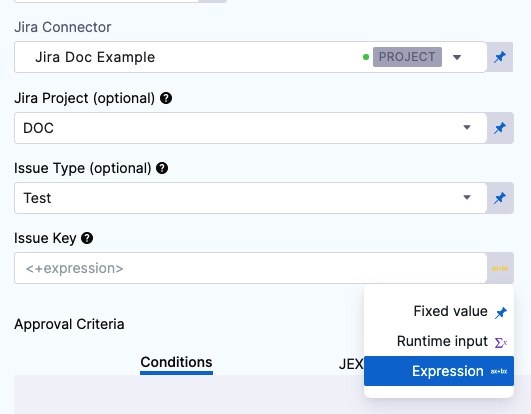
In Issue Key, paste in the expression you copied from the previous Jira Create/Update step.
With either method, the Jira Update step will use the issue created by the Jira Create step.
Some users can forget that when you use a Jira Create step it creates a new, independent Jira issue every time it is run. If you are using the same issue ID in Jira Approval, you are approving using a new issue every run.
Step 2: Set Approval Criteria
The Approval Criteria in the step determines if the Pipeline or stage is approved or rejected.
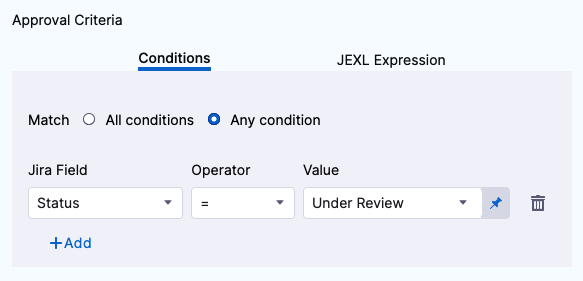
Whether the Pipeline/stage stops executing depends on the stage or step Failure Strategy. You can specify criteria using Conditions and/or JEXL Expression. If you use them in combination they both must evaluate to True for the step to be successful.
In Conditions, you simply use the Jira Field, Operator, and Value to define approval criteria. Four supported operators are =, !=, in, and not in.
For example,
- The condition for the
Statusfield to be inApproved,Done, orPublishedcan be specified as:
- The condition for the
Statusfield to not be in eitherBlocked,Invalid, orTo Docan be specified as:
- The condition for the
Statusfield to be inApproved,Done, orPublishedwithoutIssue Typecan be specified as:
Multiple conditions with the same Jira field are not allowed. Such use cases can be solved using in, not in operators, or JEXL Expression.
In JEXL Expression, you can use JEXL expressions. You can use a JEXL expression if the field is set to Fixed value, Runtime input, or Expression.
Option: Set Rejection Criteria
In Optional Configuration, in Rejection Criteria, you can define criteria for rejecting the approval.
If you add rejection criteria it is used in addition to the settings in Approval Criteria.
Option: Advanced Settings
In Advanced, you can use the following options:
Step 3: Apply and Test
Click Apply Changes. The Jira Update step is added to the stage.
Run the Pipeline.
When the Jira Approval step is reached, you can see its approval and rejection criteria:
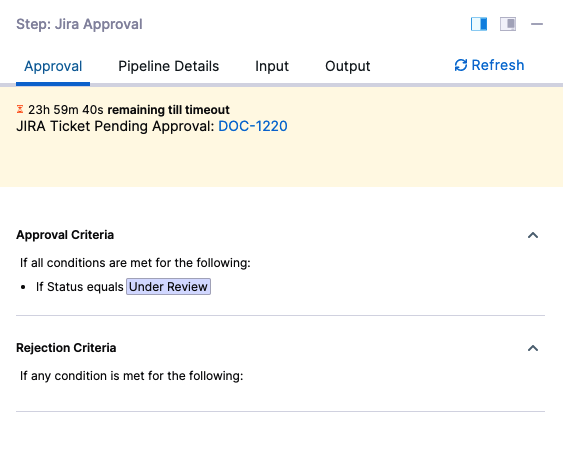
You can also click the JIRA Ticket Pending Approval link to open the ticket.
The step can take a few minutes to receive information from Jira.
Review: Issue expressions
You can use <+issue> to refer to the value in the Issue Key setting.
For example, <+issue.Status> == "Done" in the Approval Criteria JEXL Expression checks to see in the status of the issue in Issue Key is Done:
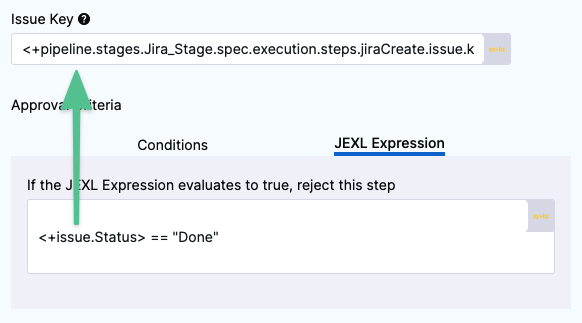
Status is an issue field. You can use any issue field.
Referencing JIRA fields with spaces or special characters
When referencing JIRA custom fields that contain spaces or special characters in their names, you must enclose the field name in single quotes (') within the Harness expression. Without quotes, the expression evaluation will fail.
Examples:
Fields with spaces - Correct syntax:
<+issue.'Risk Level'> == "High"
<+issue.'1-line Update'> == "test"
<+issue.'Remaining Estimate'> == "2h"
Fields without spaces - No quotes needed:
<+issue.Priority> == "P1"
<+issue.Status> == "Done"
<+issue.Description> == "new description"
Complex expression combining both:
((<+issue.'Risk Level'> == "High") && (<+issue.Labels>.indexOf('crm-approved') >= 0)) || (<+issue.'Risk Level'> == "Low")
This expression checks if:
- The "Risk Level" custom field equals "High" AND the Labels field contains "crm-approved", OR
- The "Risk Level" custom field equals "Low"
Incorrect syntax (will fail):
<+issue.Risk Level> == "High" // FAILS - no quotes around field name with space
<+issue.customfield_1234> == "High" // May work for custom field IDs, but use field names with quotes for better readability
- Use single quotes (
') around field names that contain spaces or special characters - Standard field names without spaces (like
Status,Priority,Labels) don't require quotes - For better readability, use the custom field name with quotes rather than the
customfield_XXXXidentifier
Additional examples:
<+issue.Priority> == "P1" && <+issue."1-line Update"> == "test" && <+issue."Remaining Estimate"> == "2h" && <+issue.Description> == "new description"
Manual Refresh During Execution
You can do a manual status refresh in the Pipeline Studio Execution view.
When the step is waiting for a response from Jira, you can use the Refresh button to immediately fetch the latest status of the approval ticket instead of waiting for the polling interval.
Use the refresh option when:
- The approval condition in Jira was updated after the step began execution.
- You need quicker response handling for fast-track approvals such as incident mitigations or emergency changes.
To use the refresh button:
- Execute a pipeline with a Jira Approval step.
- In the Pipeline Studio Execution view, locate the approval step.
- If the step is in a waiting state, click the Refresh button.
- The step will re-evaluate the condition and proceed if the criteria are met.
Notes
- To add comments in you can use Comment key. Use
\\for line breaks.
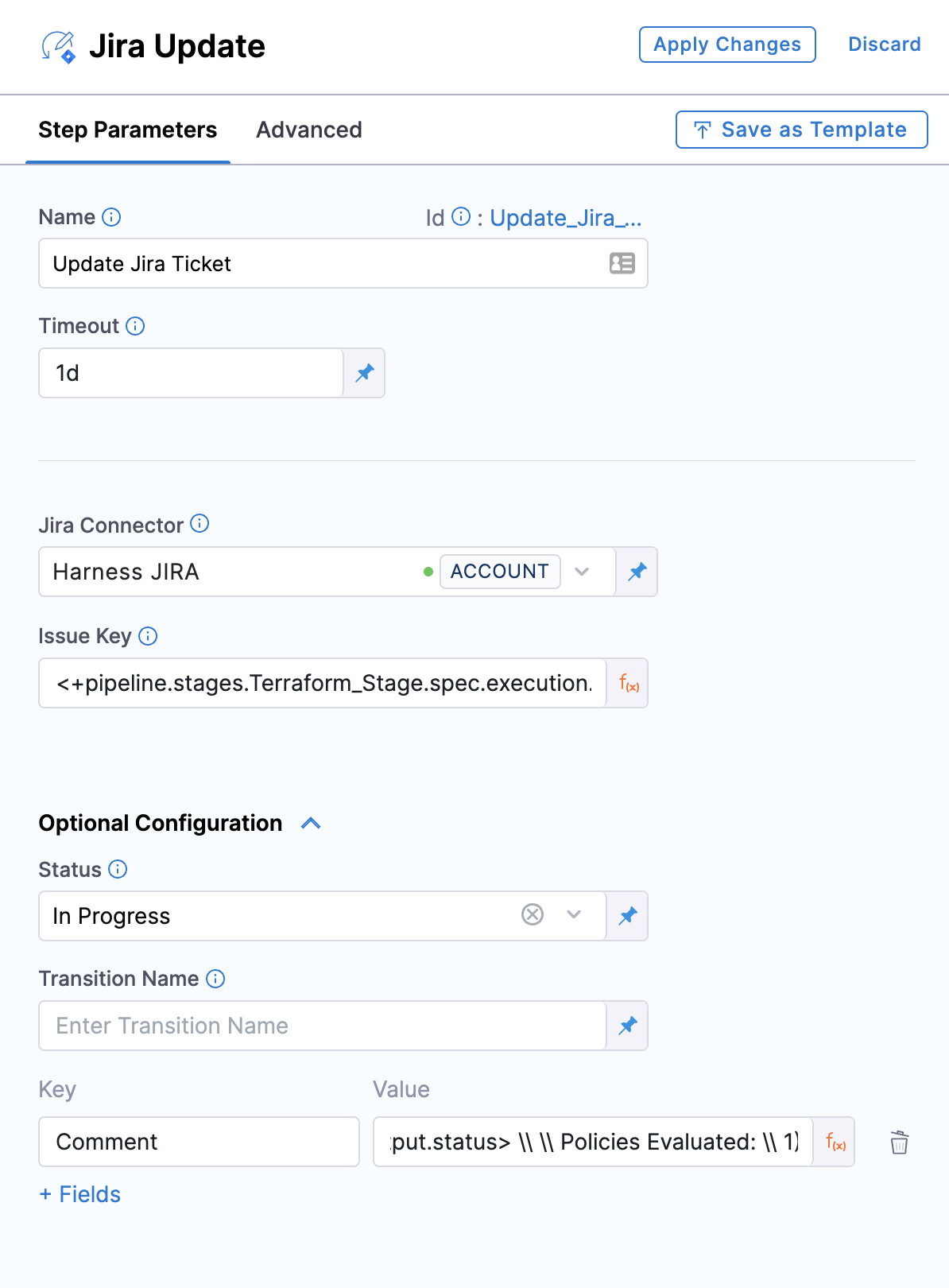
- For more information about approval log limitations, go to Deployment logs and limitations.
See also
Adding ServiceNow approval steps and stages
You can use ServiceNow tickets to approve or reject a Pipeline or stage at any point in its execution.
During deployment, a ServiceNow ticket's fields are evaluated according to the criteria you define, and its approval/rejection determines if the Pipeline or stage may proceed.
Approvals can be added as stages or in-between stage steps to prevent stage execution from proceeding without approval.
For example, in a Kubernetes Blue Green Deployment, you might want to add an approval step between the Stage Deployment step, where the new app version is deployed to the staging environment, and the Swap Primary with Stage step, where production traffic is routed to the pods for the new version.
Before you begin
Review: ServiceNow Approval Stages vs Steps
You can use ServiceNow Approvals in two ways:
-
ServiceNow Approval step: you can add a ServiceNow Approval step to any Pipeline or Approval stage.
-
ServiceNow Approval stage: the ServiceNow Approval stage.
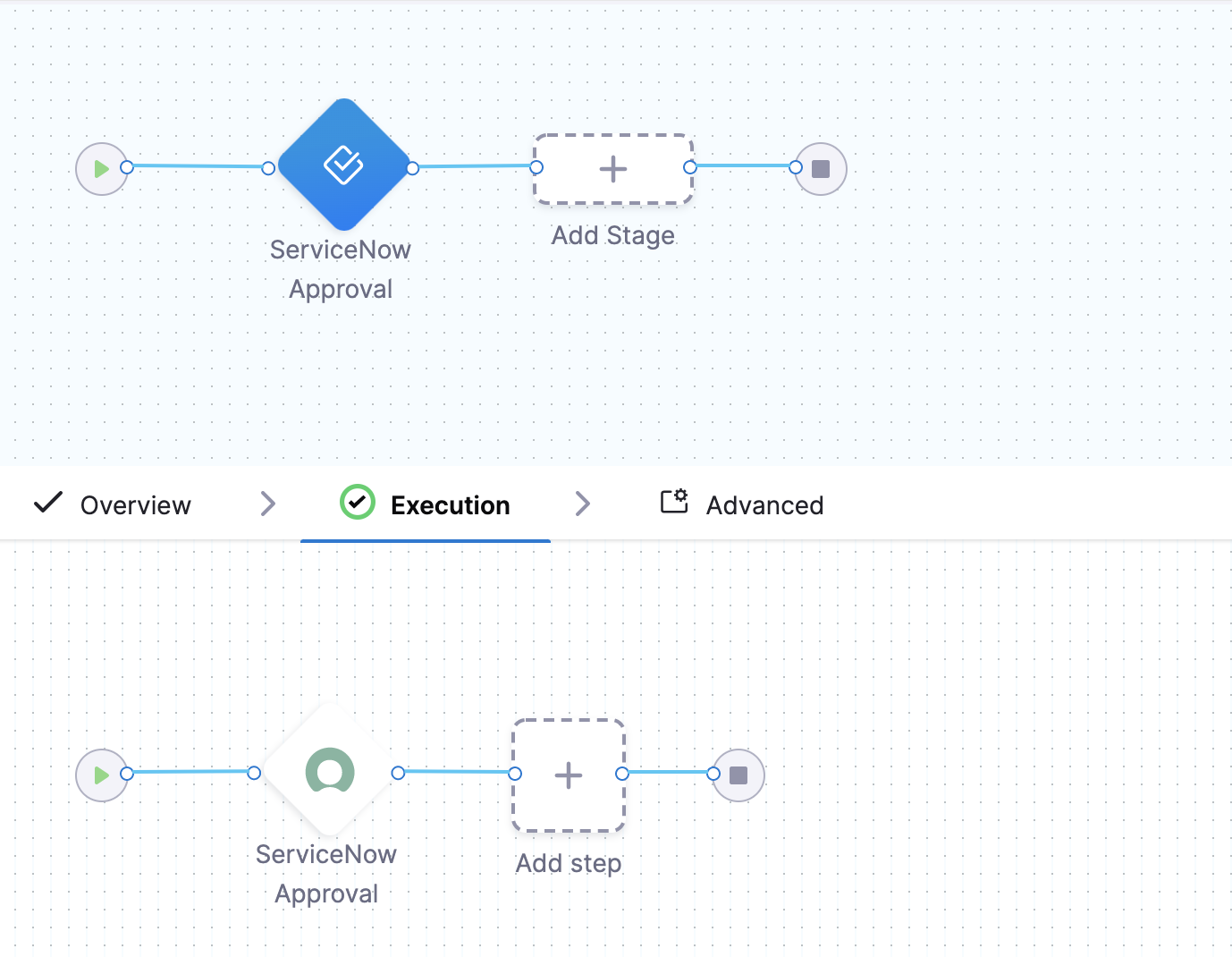
UTC Timezone Only
The ServiceNow API only allows date time and time values in the UTC timezone. Consequently, input for any datetime/time fields in Harness ServiceNow steps must be provided in UTC format irrespective of time zone settings in your ServiceNow account.
The timezone settings govern the display value of the settings not their actual value.
The display values in the Harness UI depend on ServiceNow timezone settings.
Step: Add an Approval Step
In your Pipeline, click Add Stage.

Click Approval. The Stage settings appear.
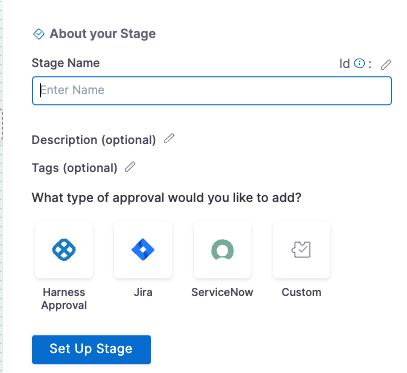
In Name, enter a name for your Stage and select ServiceNow as approval type. Click Setup Stage. The pipeline appears.
In the pipeline, click ServiceNow Approval. The ServiceNow Approval settings appear.
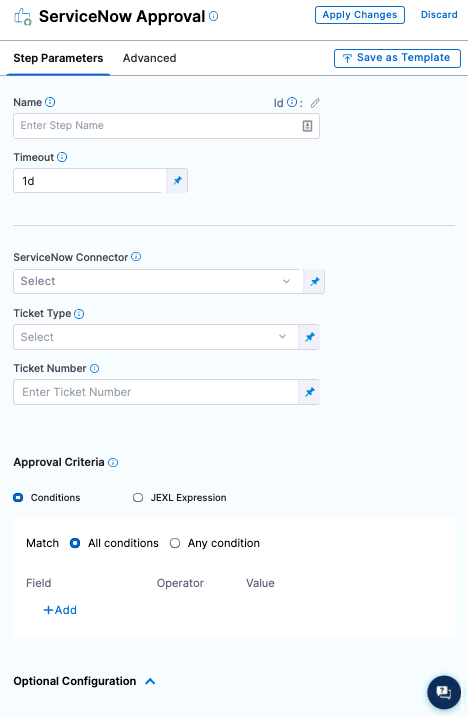
In Timeout, enter how long you want Harness to try to complete the step before failing (and initiating the stage or step Failure Strategy).
You can use **w** for week, **d** for day, **h** for hour, **m** for minutes, **s** for seconds and **ms** for milliseconds. For example, 1d for one day.
ServiceNow communication can take a few minutes. Do not use a brief timeout.
The maximum is 3w 3d 20h 30m. In ServiceNow Connector, create or select the ServiceNow Connector you want to use.
Select the ServiceNow Ticket Type. Use the same type as the ticket you created in the Workflow.
Enter the ServiceNow Ticket Number.
In Retry Interval, set how long the step should wait to fetch details again for calculating Approval or Rejection criteria.
Step 2: Set Approval Criteria
The Approval Criteria in the step determines if the Pipeline or stage is approved or rejected. Define the approval criteria using the ServiceNow status items.
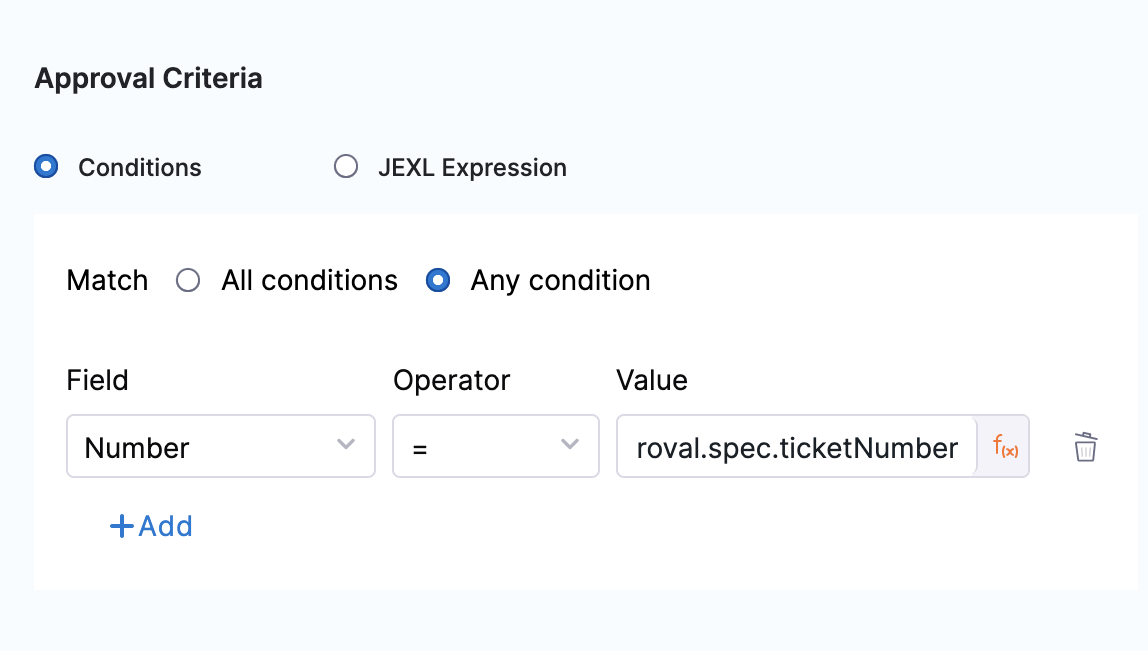
Whether the Pipeline/stage stops executing depends on the stage or step Failure Strategy.You can specify criteria using Conditions and/or JEXL Expression. If you use them in combination, they both must evaluate to True for the step to be successful.
In Conditions, you can use the ServiceNow ticket related fields to define approval criteria. Four supported operators are =, !=, in, and not in.
For example,
- The condition for the
Statefield to be inResolved,Closed, orCancelledcan be specified as:
- The condition for the
Statefield to not be in eitherNew,In Progress, orOn Holdcan be specified as: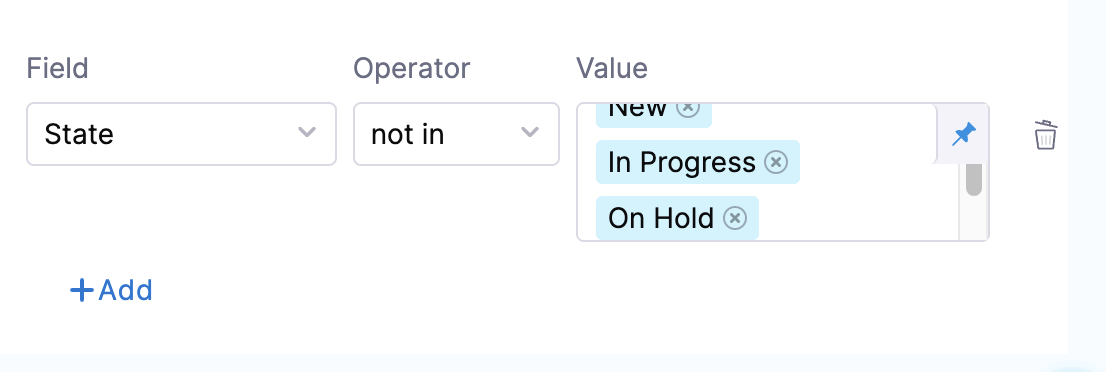
- The condition for the
Statefield to be inResolved,Closed, orCancelledwithout fixedTicket Typecan be specified as:
Multiple conditions with the same Jira field are not allowed. Such use cases can be solved using in, not in operators, or JEXL Expression.
In JEXL Expression, you can use JEXL expressions. You can use a JEXL expression if the field is set to Fixed value or Expression.
Option: Set Rejection Criteria
In Optional Configuration, in Rejection Criteria, you can define criteria for rejecting the approval. Define the rejected criteria using the ServiceNow status items.
If you add rejection criteria, it is used in addition to the settings in Approval Criteria.
Option: Approval Change Window
In Approval Change Window, use Window Start and Window End values to specify the window in which Harness will proceed with the deployment. Once this step is approved, Harness proceeds with deployment if the current time is within this window. The values that appear depend on the type selected in Ticket Type.
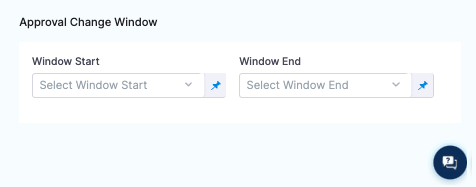
The start and end times use the time zone set in the ServiceNow account selected in the ServiceNow Connector.
Option: Advanced Settings
In Advanced, you can use the following options:
Step 3: Apply and Test
Click Apply Changes. The ServiceNow approval step is added to the stage.
Run the Pipeline.
When the ServiceNow Approval step is reached, you can see its approval and rejection criteria:
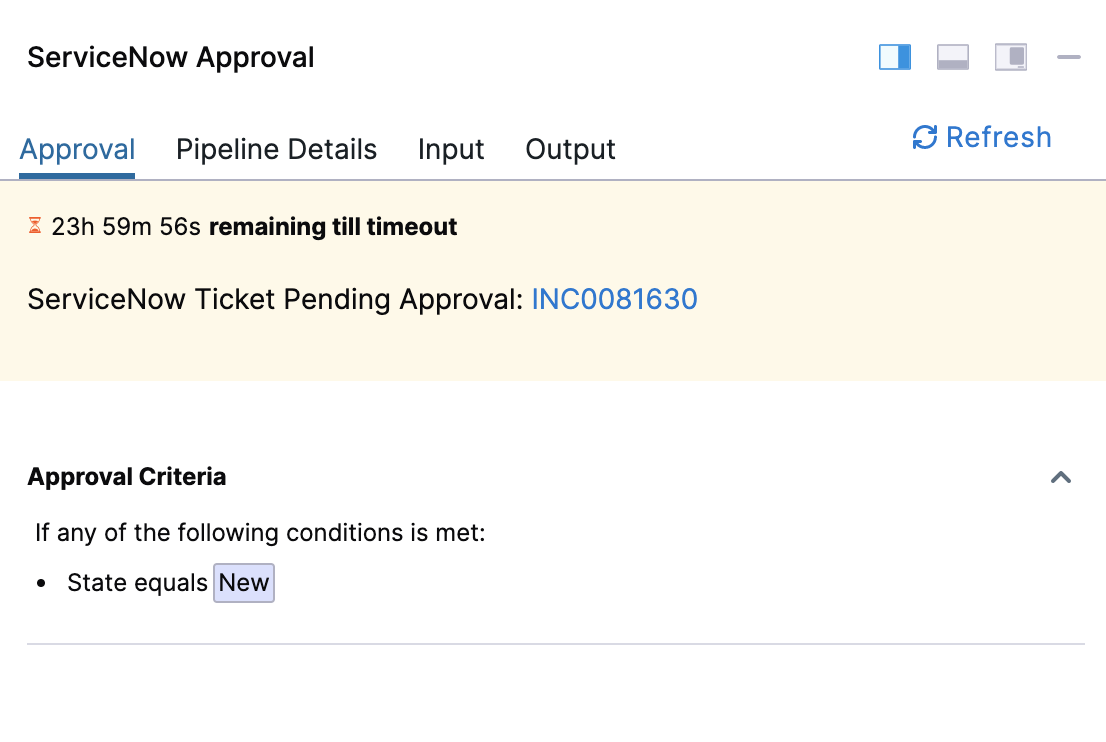
Review: Issue expressions
You can use <+ticket> to refer to the value in the JEXL Expression setting.
For example, <+ticket.state.displayValue> == "New" in the Approval Criteria, JEXL Expression checks to see if the status of the ticket is New.
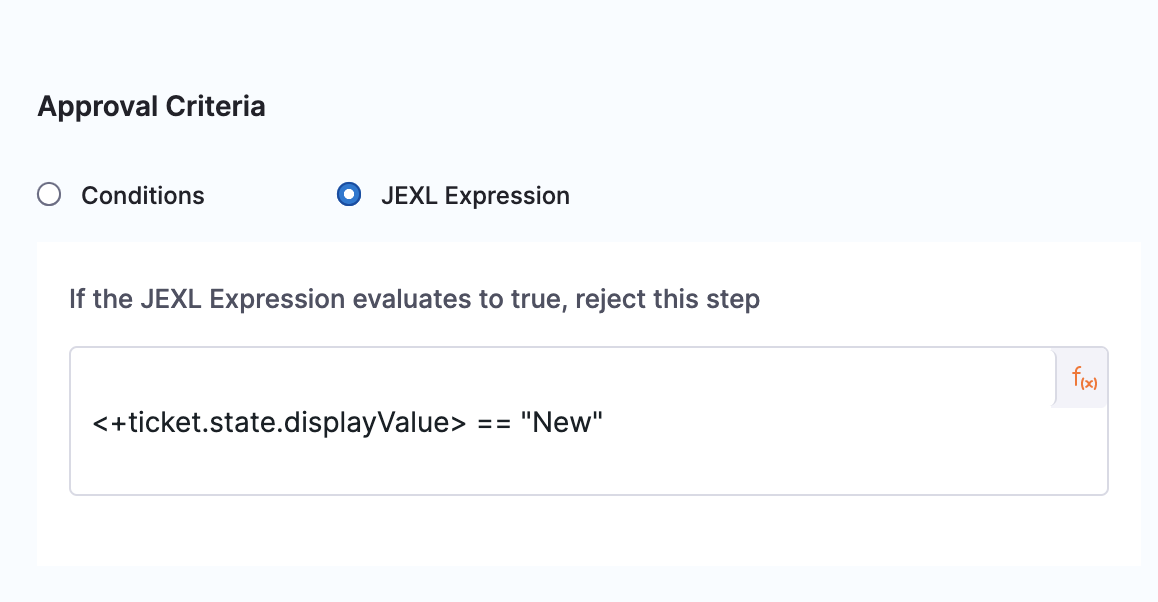
state is a ticket field. You can use any ticket field.
Manual Refresh During Execution
You can do a manual status refresh in the Pipeline Studio Execution view.
When the step is waiting for a response from ServiceNow, you can use the Refresh button to immediately fetch the latest status of the approval ticket instead of waiting for the polling interval.
Use the refresh option when:
- The approval condition in ServiceNow was updated after the step began execution.
- You need quicker response handling for fast-track approvals such as incident mitigations or emergency changes.
To use the refresh button:
- Execute a pipeline with a ServiceNow Approval step.
- In the Pipeline Studio Execution view, locate the approval step.
- If the step is in a waiting state, click the Refresh button.
- The step will re-evaluate the condition and proceed if the criteria are met.
Output
Regardless of whether the step is approved or rejected, the ServiceNow approval step will provide outputs referencing the details of the step, such as:
ticketTypeticketNumberApproval CriteriaRejection CriteriaConditionshasApprovalCriteriaMethasRejectionCriteriaMet
These outputs can be used as output variables and referenced in subsequent steps or stages.
Here are a few expression examples that can be used to fetch the output values:
- ticketType:
<+pipeline.stages.stage.spec.execution.steps.ServiceNowApproval_1.output.ticketType> - ticketNumber:
<+pipeline.stages.stage.spec.execution.steps.ServiceNowApproval_1.output.ticketNumber> - approvalCriteria:
<+pipeline.stages.stage.spec.execution.steps.ServiceNowApproval_1.output.approvalCriteria.type> - rejectionCriteria:
<+pipeline.stages.stage.spec.execution.steps.ServiceNowApproval_1.output.rejectionCriteria.type>
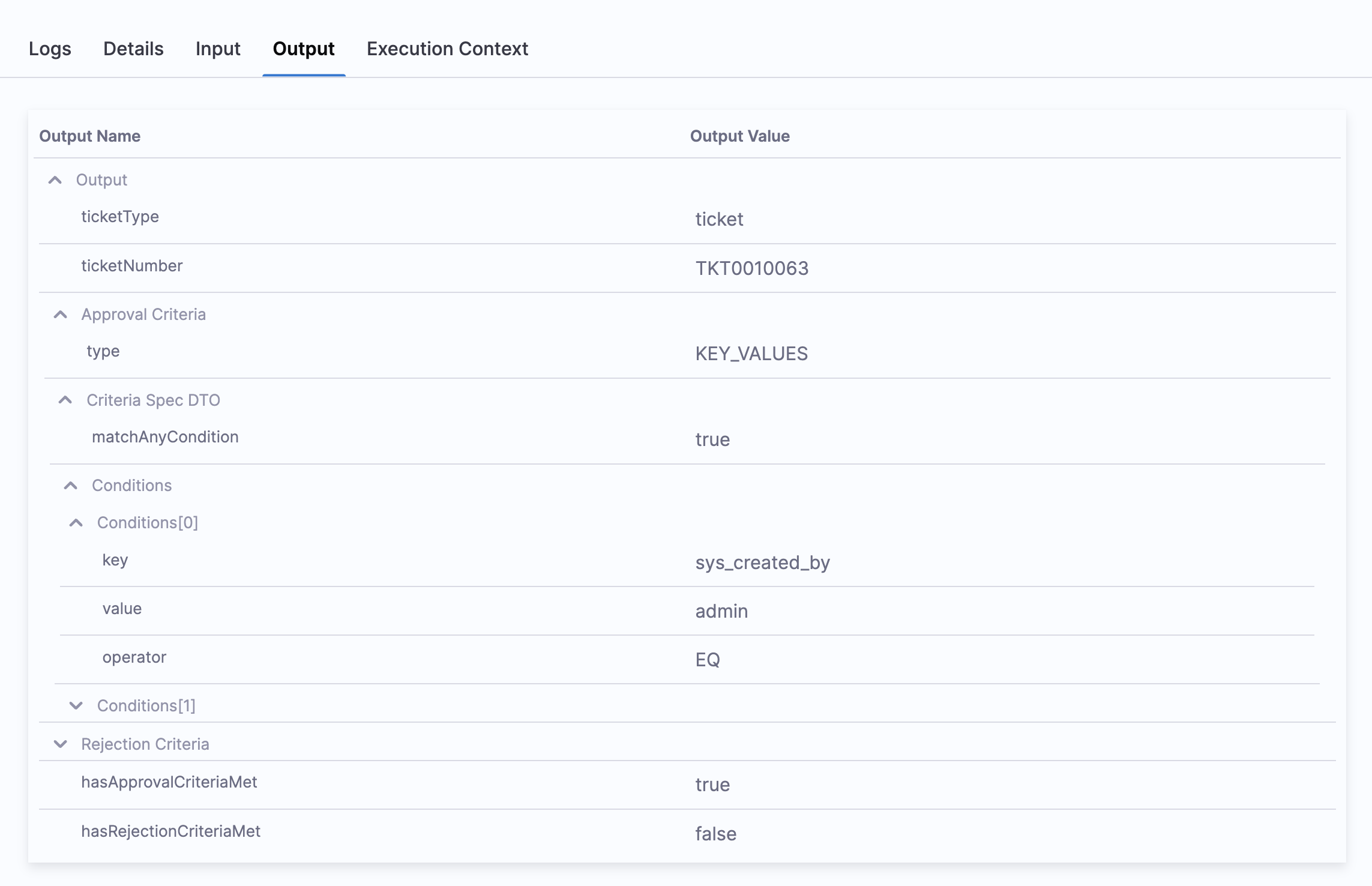
Logs
You can also view detailed logs that describe why the validation failed or succeeded in the ServiceNow approval step.
Here are examples of logs for different scenarios:
-
Log example for an approved step:
The logs will show the approval criteria on which the step was approved and the evaluating condition.
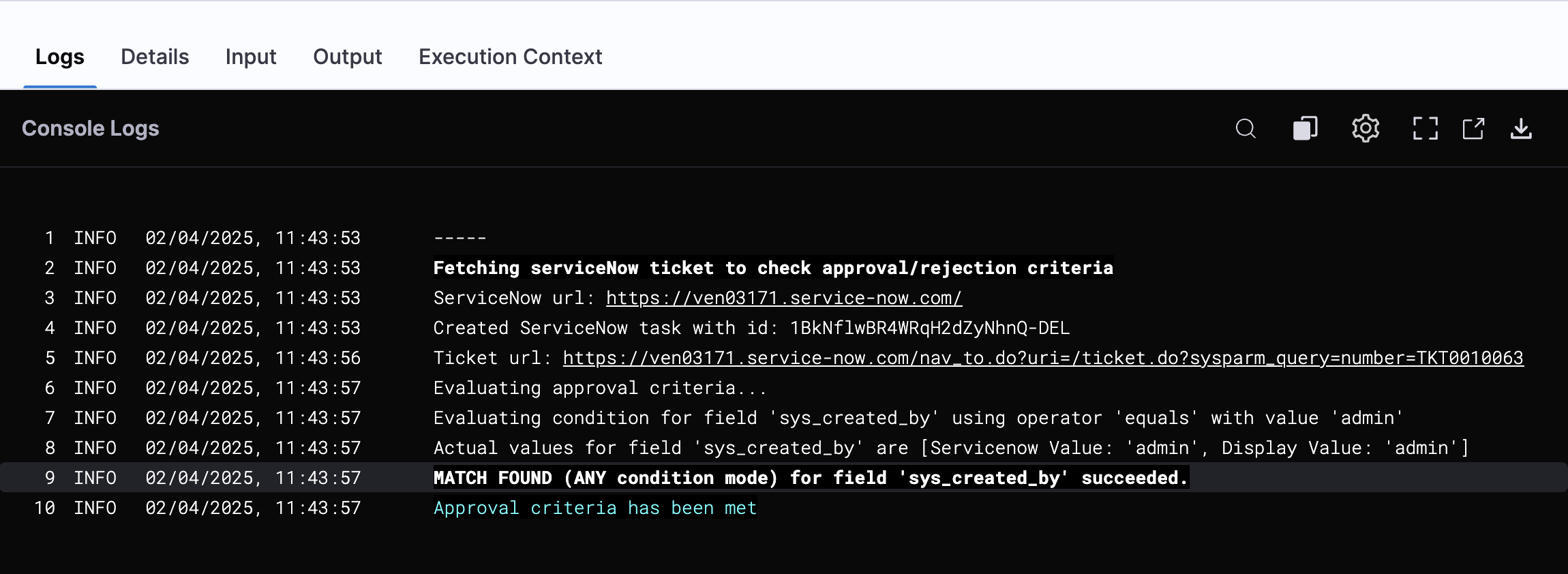
-
Log example for a rejected step:
The logs will show the rejection criteria on which the step was rejected and the evaluating condition.
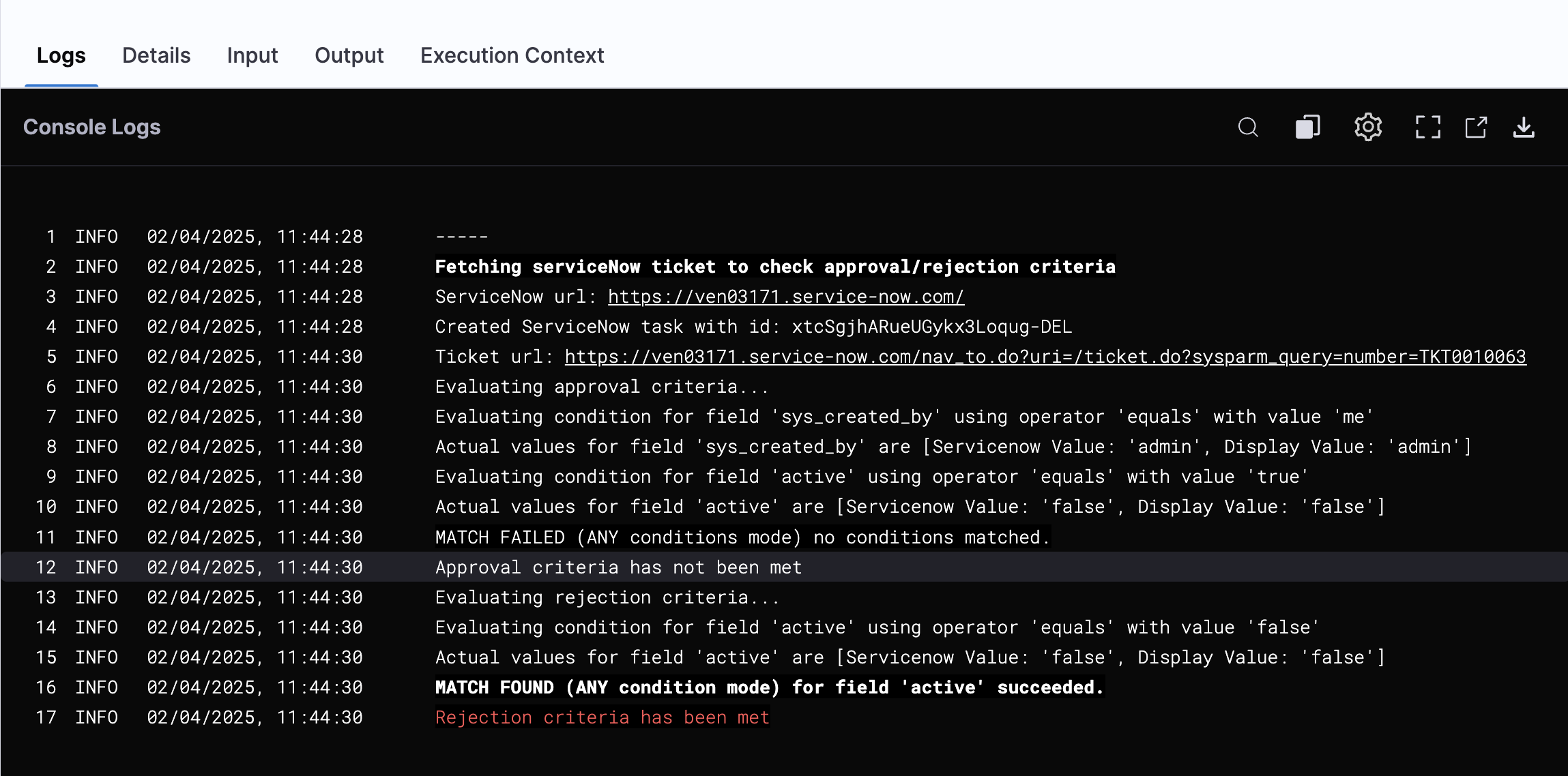
-
Log example for using JEXL expression in approval criteria:
The logs will show the JEXL expression on which the step will be approved or rejected and how the condition is evaluated.
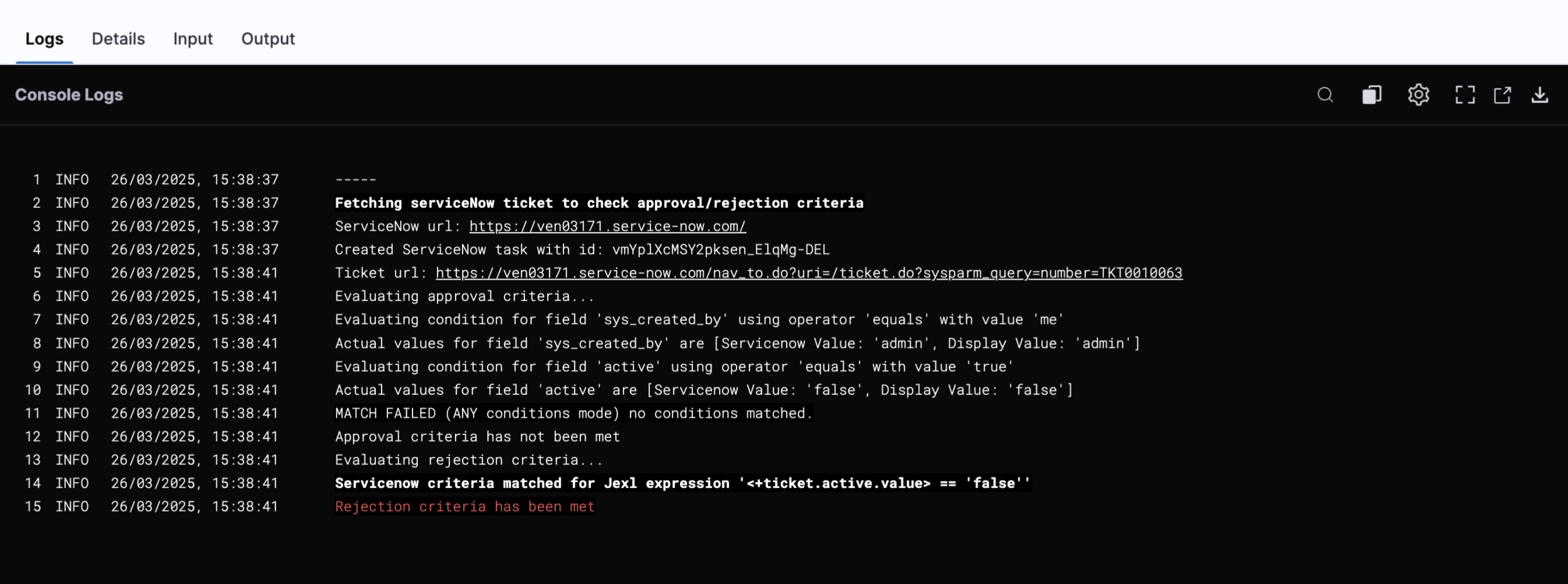
Custom table support
For details, go to Custom table support in Create ServiceNow tickets in CD stages.
Notes
- For more information about approval log limitations, go to Deployment logs and limitations.